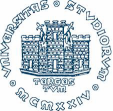- Laura Caravenna: Fine properties and regularity in conservation laws
Conservation laws are first order partial differential equations which appear in the modeling of physical and engineering problems: they describe constraints on how certain quantities (for example mass, momentum, energy) vary in time and in the space variables. Even if the initial datum is smooth, due to nonlinearity a smooth solution of a conservation law will in general break down in finite time, owing to the formation of discontinuities, and this qualitative feature agrees with the phenomena that the equations model. From the mathematical viewpoint, the formation of discontinuities and of other types of irregular behaviors poses severe challenges in the analysis of this class of equations. Despite severe restrictions, some regularity results are available for conservation laws: these results are relevant from both theoretical and applicative purposes.
In my presentation I will highlight few major achievements in the general theory of 1d conservation laws. I will then report on some of the present research concerning fine properties and regularity issues, better focusing on the following topic. In 1973 Schaeffer established a regularity theorem that applies to scalar (i.e., real-valued) conservation laws with uniformly convex fluxes and which can be roughly speaking formulated as follows: for a generic smooth initial datum, the admissible solution is smooth outside a locally finite number of curves in the time-space plane. Here the term "generic" should be interpreted in a suitable topological sense, related to the Baire Category Theorem. In my talk I will introduce the positive and negative results which are available, illustrating a recent explicit mathematical counter-example that shows that Schaffer's Theorem does not extend to nonlinear hyperbolic systems of conservation laws.
- Elisa Davoli: A-quasiconvexity with variable coefficients: relaxation and homogenization
Constrained relaxation and homogenization problems are a central question in materials science. Many applications in continuum mechanics rely in fact on the characterization of equilibrium states or on the understanding of the microstructure of new materials exhibiting interesting, and technologically powerful, elastic and magnetic behaviors. Mathematically, understanding these phenomena often translates into the analysis of non-convex integral energies evaluated on fields subject to partial differential constraint of the form Au=0, where A is a suitable differential operator.
A key technique to tackle constrained minimization problems is the notion of A-quasiconvexity, introduced by B. Dacorogna in 1982 for differential operators A having constant coefficients. In this talk, after reviewing the main ideas and classical results, I will discuss some recent results obtained in collaboration with I. Fonseca and dealing with relaxation and homogenization in the framework of A-quasiconvexity, when the operator A has coefficients depending on the space variable.
- Matteo Gallet: Planar linkages following a prescribed motion
Designing mechanical devices, called linkages, that draw a given plane curve has been a topic that interested engineers and mathematicians for hundreds of years, and recently also computer scientists. Already in 1876, Kempe proposed a procedure for solving the problem in full generality, but his constructions tend to be extremely complicated. I will report about a work together with the colleagues of the Symbolic Computation group in Linz that provides a novel algorithm that produces much simpler linkages, but works only for parametric curves. Our approach is to transform the problem into a factorization task over some noncommutative algebra. I will show how to compute such a factorization, and how to use it to construct a linkage tracing a given curve.
- Aleks Jevnikar: Liouville-type problems on compact surfaces: a variational approach
A large number of important second order nonlinear elliptic equations involve exponential nonlinearities. We focus on the Liouville equation which is related to the prescribed Gaussian curvature problem and discuss its variational aspects. We next consider the Toda system which arises in mathematical physics in the Chern-Simons theory and in geometry in the description of holomorphic curves and discuss how the variational arguments can be adapted to the system case.
- Andrea Mondino: Smooth and non-smooth aspects of Ricci curvature lower bounds
After recalling the basic notions coming from differential geometry, the talk will be focused on spaces satisfying Ricci curvature lower bounds. The idea of compactifying the space of Riemannian manifolds satisfying Ricci curvature lower bounds goes back to Gromov in the '80s and was pushed by Cheeger and Colding in the '90s who investigated the fine structure of possibly non-smooth limit spaces. A completely new approach via optimal transportation was proposed by Lott-Villani and Sturm almost ten years ago. Via such an approach one can give a precise definition of what means for a non-smooth space to have Ricci curvature bounded below. Such an approach has been refined in the last years giving new insights to the theory and yielding applications which seems to be new even for smooth Riemannian manifolds.
- Nicola Pagani: The Franchetta conjecture and some of its recent consequences
A general approach in mathematics to attack a complicated problem is by "approximation to the first order". One incarnation of this approach is to study the geometry of a smooth space X by studying its tangent bundle T_X, the space whose points are pairs (p,v) with p a point of X, and v a tangent vector of X at p. When X has dimension one, the tangent space at each point is a line, which makes the tangent bundle T_X a line bundle. The Franchetta conjecture roughly says that, for smooth algebraic curves X, the only line bundles that can be chosen uniformly in X are the tangent bundle T_X and its tensor powers. The conjecture was first stated by Enriques in 1924, and an incorrect proof was given in 1954 by Franchetta. A complete proof was found in the eighties by the combined works of Harer, Arbarello-Cornalba and Mestrano. We will begin by formulating the precise statement of Franchetta's conjecture. This involves introducing the moduli space of (smooth, algebraic) curves M_g, the moduli space of line bundles on a curve and a combination of the two: the universal moduli space of line bundles on curves, called the universal Jacobian J_g. The Franchetta conjecture describes all algebraic (or holomorphic) sections of the natural map J_g -> M_g that forgets the line bundle. A similar and slightly more general version of the conjecture describes the sections of the natural forgetful map from the universal Jacobian over the moduli space of curves with marked points. We will conclude by discussing some of our recent results (joint with Jesse Kass), that describe how and when these sections uniquely extend to the natural compactifications of these moduli spaces.
- Marta Panizzut: Tropical varieties and polytopes
Tropical geometry is a recent area of mathematics at the interface between algebraic geometry and combinatorics. The tropical counterpart of algebraic varieties are tropical varieties, which are polyhedral complexes satisfying certain combinatorial properties. Loosely speaking, tropical varieties are described as "combinatorial shadows" of classical varieties, of which they retain many interesting geometrical properties. In this talk we will introduce tropical varieties, focusing in particular on tropical curves. By means of examples, we will emphasize the connection between algebraic geometry, polyhedral geometry and combinatorics.
- Fabio Tanturri: Degeneracy loci in algebraic geometry
In algebraic geometry, degeneracy loci of morphisms between vector bundles are ubiquitous: the simplest examples are complete intersection varieties, but other classical varieties such as Segre, Veronese varieties or rational normal scrolls can be interpreted as such. Starting from the easy example of determinantal varieties, I will introduce the notion of degeneracy loci and present some of the situations in which they appear, together with a few related questions and (partial) answers. Finally, I will introduce the notion of orbital degeneracy locus, which generalizes the classical definition and gives us a tool to construct several interesting varieties.
- Dragana Vuckovic: Human genetics from a mathematician's point of view
In the past 20 years the capability of reading DNA has increased exponentially generating a vast amount of data. The role of a mathematician working in human genetics is to correctly process, analyse and interpret this data on population level. The main aims are: discovering the structure of a population, determined by its history and admixture with other populations; detecting associations with observed traits and diseases known to be hereditary, in order to improve wet-lab functional experiments and further biological validation; develop tools and software capable of predicting the functional role of DNA regions. In my talk I will introduce some of the computational techniques currently used in genetics research to reach the above aims and discuss results from my recent research.
|



